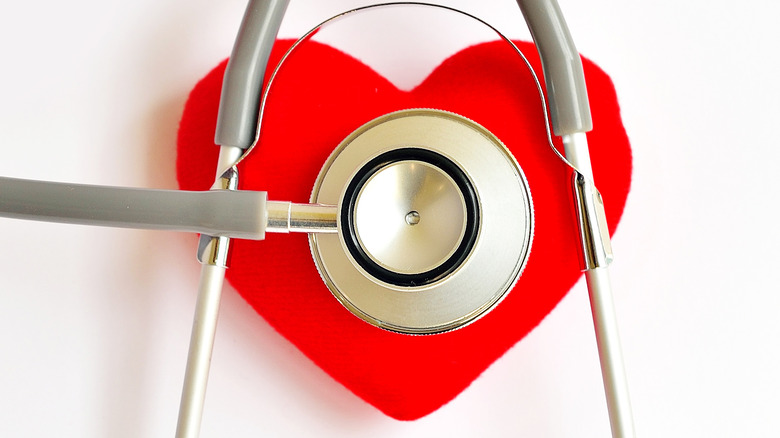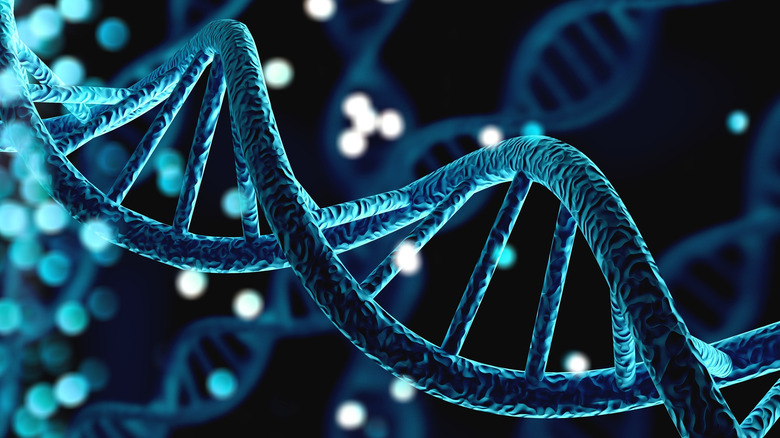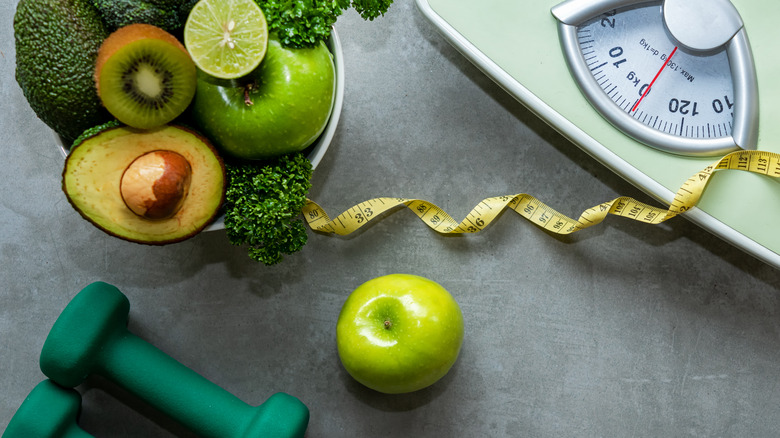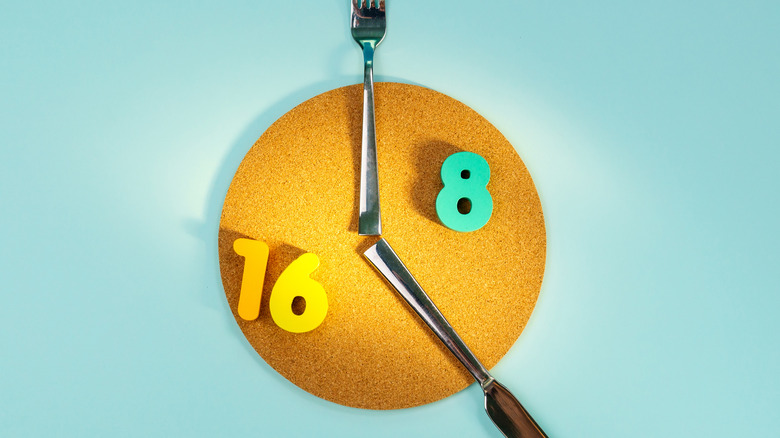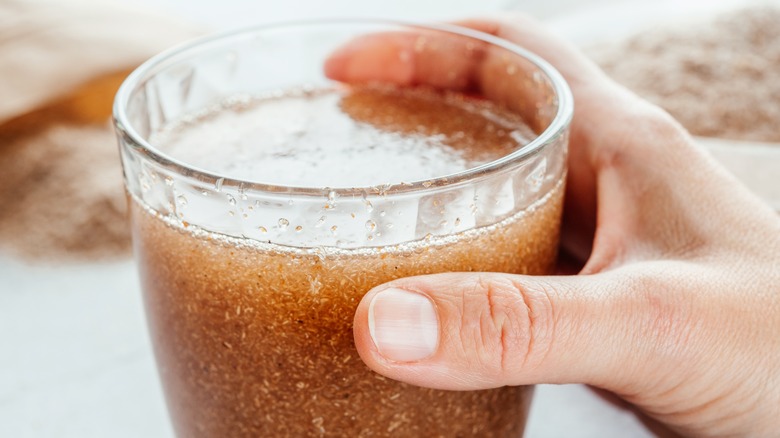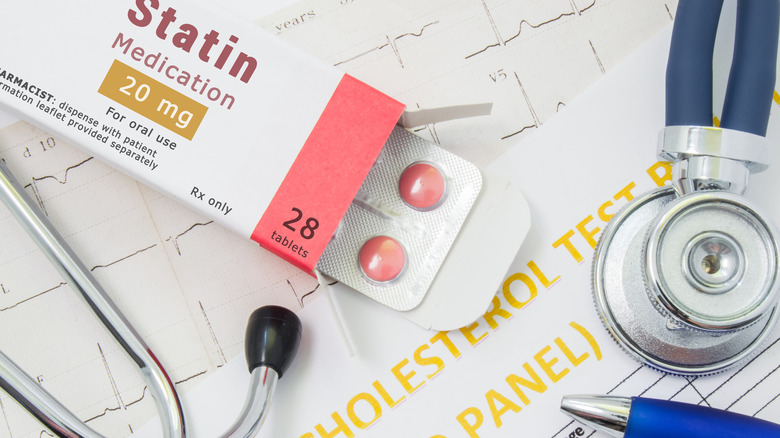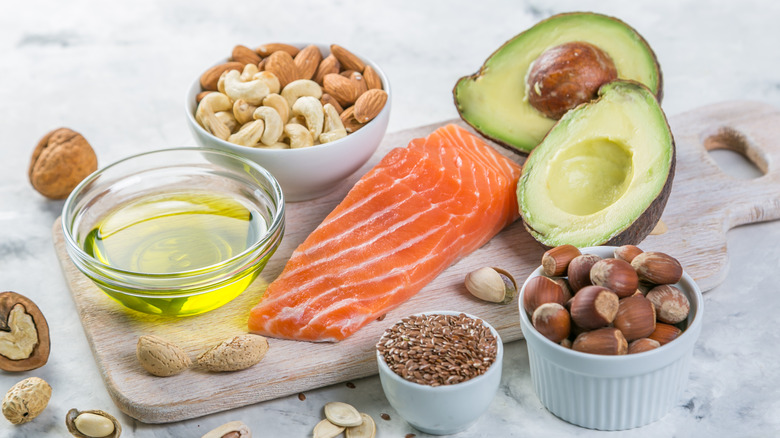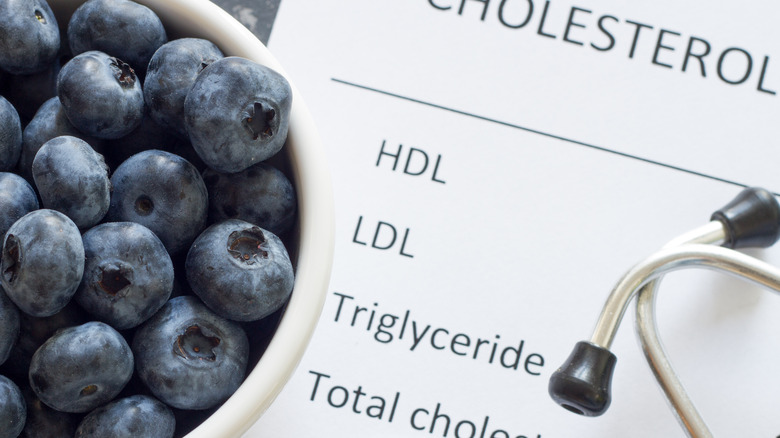Simple Ways To Lower Your Triglyceride Levels
Cholesterol has a pretty bad reputation when it comes to heart health, but there's another substance that can also cause heart problems in excess: triglycerides. According to the Mayo Clinic, triglycerides are a kind of blood fat. Unlike cholesterol which is used to build cell membranes and produce certain hormones, triglycerides act as a form of energy reservoir. After eating, any calories that are not used immediately are converted into triglycerides and kept inside your cells until needed. Hormones trigger their release into the bloodstream, usually in between meals. Eating too many calories, especially from carbohydrates, is the primary cause of elevated triglycerides (a.k.a. hypertriglyceridemia). Additionally, certain medications (such as steroids, beta blockers, and diuretics) may raise triglycerides as a side effect.
Monitoring your triglycerides is important, as high levels can signal several health conditions, including type 2 diabetes, metabolic syndrome, and hypothyroidism. Metabolic syndrome is of particular concern because it greatly increases your risk of developing heart disease, per WebMD. Other hallmarks of the condition include high blood sugar, elevated blood pressure, overabundance of belly fat, and high "bad" cholesterol (LDL). Along with high sugar/carb foods, too much saturated fat in the diet from meat, butter, and whole milk dairy may also contribute to high triglycerides.
Fortunately, many of the lifestyle choices that lower cholesterol and promote general health can also improve your triglyceride levels. In this article, we will review some helpful strategies to help you lower your triglycerides.
High triglyceride risk factors
If you're keeping an eye on your triglyceride levels, it's helpful to know some of the common risk factors for hypertriglyceridemia.
Although food is the primary source of triglycerides, the liver also makes triglycerides, which may explain variation between people who eat a similar diet but have different triglyceride levels (via the University of Rochester Medical Center). Like cholesterol, genes can also play a factor in this, such as in the inherited condition known as familial hypertriglyceridemia that makes you more prone to having heightened triglyceride levels, according to WebMD.
Some of the high-risk groups that may want to pay particular attention to their triglyceride levels include adults with a history of heart attack or stroke, adults with diabetes, and anyone at risk for heart attack or stroke due to high cholesterol or other risk factors such as family history (per the University of Rochester Medical Center).
Reduce your carbohydrate intake
One of the most effective ways to lower triglycerides is to monitor your carbohydrate consumption. Extra calories in the form of carbs are converted into triglycerides quite efficiently, according to Healthline.
In fact a 2020 meta-analysis (review) of 12 randomized, placebo controlled studies (the gold standard for a study) published in the journal PLOS ONE showed a reduction in triglyceride levels following a low-carb diet over 6-24 months, with the most dramatic reduction occurring in only the first 6 months. Furthermore, those following a low-carb diet saw greater decreases in triglycerides compared to those following a low-fat diet, demonstrating the emphasis on macronutrient restriction in the form of carbs as the most effective for lowering triglycerides.
This might seem counterintuitive because carbs are not fat, but remember that carbs can be converted into triglycerides. The fact that triglycerides dropped most dramatically in the first 6 months further demonstrates that it doesn't take long for dietary changes to benefit triglyceride levels.
Lower your sugar intake
In addition to starchy carbs like bread and pasta, added sugars can also be converted into triglycerides. This explains part of the link between increased added sugars in the diet and increased cardiovascular risk factors like insulin resistance (via Healthline).
A 2020 review in the Journal of the American Heart Association assessed data from a large cohort of nearly 7,000 people. It found that those who consumed sugary beverages regularly were 50% more likely to have high triglycerides than those who only drank them occasionally — a startling difference that highlights the importance of minimizing excess sugar in the diet. Regular consumption of sugar-sweetened beverages also had adverse effects on good (HDL) cholesterol.
The American Heart Association (AHA) recommends limiting sugar consumption to six teaspoons per day for women and nine teaspoons per day for men (about 100-150 calories, or just 25-38 grams of sugar, per day). That may not seem like much, but that this only pertains to added sugar. Sugars occur naturally in many unprocessed foods such as fruits, certain vegetables (e.g., carrots, sweet corn, or beets), and milk, but these foods don't count toward your daily added sugar allotment (as they are not added). Still, given that a can of Pepsi has a whopping 39 grams of sugar, this isn't much added sugar. If you get your sweet fix from natural sources like fruit and limit added sugars to the occasional treat, you'll be more successful at staying in this range.
Hacks for reducing sugar intake
Sugar is added to many foods, so reducing your intake may be more challenging than you think. Fortunately, the American Heart Association has some great tips. These include throwing out your sugar canister, recognizing the different forms of sugar, and understanding that they are all the same, even if they're marketed as "healthy" (e.g., brown sugar, agave nectar, honey, crystalline sugar, maple syrup, and molasses).
You can also try adding fruit to your oatmeal in place of sugar for natural sweetness, swapping sparkling water or plain water for juice or soda, or flavoring your recipes with extracts such as almond, vanilla, or lemon in place of sugar. Non-nutritive sweeteners like allulose or stevia can also be used, but you should be careful with this, as some research shows these may increase sugar cravings later (via the American Heart Association).
You should also read food labels, as many foods not thought of as particularly sweet (like bread and yogurt) commonly have hidden added sugars in them. Most food labels will show "Total Sugars" vs. "Incl. Added Sugars" on the label, so you can see how much sugar was added to a food compared to the total amount of sugar in a product. For example, a box of the popular "healthy" cereal Honey Nut Cheerios has 12 grams of "total sugars." Right below it, you see it says "Incl. Added Sugars 12g." This means that all of the sugar in Honey Nut Cheerios has been added.
Lose weight if overweight
Eating more calories than you burn is the primary cause of high triglycerides, per Medical News Today. This is because excessive energy intake is converted into excessive triglycerides — making obesity and being overweight a risk factor for high triglycerides.
Eating fewer calories than you burn, on the other hand, forces the body to burn through the excess triglycerides for energy, resulting in a reduction in blood triglycerides. This explains why even a modest 5-10% weight loss can reduce triglyceride levels as much as 20%, and also explains the direct correlation between pounds lost and reduction in triglyceride levels.
The National Lipid Association recommends focusing on smaller portions of calorie-dense foods and larger portions of low-calorie yet filling foods like vegetables and lean meats to help with weight loss and reduce triglycerides. Other tips that can help weight loss include limiting starchy foods, getting 30 minutes of moderate exercise most days of the week, limiting or avoiding alcohol consumption, and limiting one's intake of sugary foods.
Tips for losing weight
Weight loss isn't easy, but there are effective strategies to help you get a leg up. According to Medical News Today, studies have shown intermittent fasting to be an effective weight management strategy. Unlike calorie counting, you restrict the time you eat instead of what you eat, leading to lower feelings of restriction.
You can also pair time-restricted eating with a healthy diet for best results. For example, you might fast for 16 hours and eat all your meals in an 8-hour window; on a more advanced regimen, you might fast every other day, eating one day and up to 30% of your body's energy needs the next -– it's up to you. Many apps can help with fasting or general meal tracking; research even shows that consistently tracking what you eat can greatly improve the odds of weight loss.
Additionally, you can practice mindful eating tips like sitting down while eating, avoiding distractions like your smartphone or T.V., and eating slowly to give your brain more time to recognize the sensation of fullness. Lastly, a higher emphasis on protein in the diet has shown to increase satiety and improve weight loss, because protein causes the body to release appetite-reducing hormones like GLP-1 and peptide YY following consumption (via Healthline). A 2005 study in the American Journal of Clinical Nutrition showed that people reduced their calorie intake by a whopping 440 calories per day without trying by increasing protein from 15% to 30% of their diet.
Eat more fiber
Eating more fiber is another simple yet effective way to curb your triglycerides, according to SFGate. There are two types of fiber: soluble and insoluble. Soluble fiber dissolves in water (hence the name), whereas insoluble water does not.
Both fibers provide a multitude of health benefits, but soluble fiber is most beneficial when it comes to both triglycerides and cholesterol improvements. It works by reducing the absorption of sugars and fats in your small intestine by "sopping up" and binding to these food components so they cannot be digested and leave the colon intake. This, in turn, limits the amount of fats and sugars that can be converted into triglycerides. Soluble fibers are derived mainly from plant substances called pectins and gums, which are found in many plant-foods such as strawberries, apples, peaches, oatmeal, beans, and legumes.
Women should aim for about 21-25 grams of total fiber per day, whereas men should aim for 30-38 grams daily. If you eat a variety of plant foods like fruits, veggies, whole grains, and beans, you'll likely get a good balance of soluble to insoluble fiber in your diet. You can also try adding a fiber supplement or fiber beverage like dextrin or psyllium husk added to water if you have difficulty getting all your fiber from food.
Avoid trans fats
Trans fats are a type of man-made fat that are particularly bad for your heart and health overall. Made by adding hydrogen to liquid vegetable oils in an effort to increase their shelf life and impart a smoother, richer taste in certain foods, these synthetic oils have many detrimental health effects, including raising bad cholesterol and triglyceride levels (via EverydayHealth). Moreover, a 2011 review published in the Journal of Food Science and Technology demonstrated a direct connection between trans fatty acids and preeclampsia (a dangerous pregnancy condition), preterm birth, breast cancer, diabetes, obesity, colon cancer, and even neurological and vision disorders in infants.
Any food with "hydrogenated oils" or "partially hydrogenated oils" has trans fat, even if the label says "0 grams" of trans fat. That is because food companies are allowed to leave that information out if it contains less than a gram per serving. Naturally, if you eat multiple servings of a food, this adds up very quickly. The World Health Organization recommends limiting trans fats to less than 1% of your total daily calories.
Be sure to read food labels, and be especially wary of foods like margarine, vegetable shortening, baked goods, and processed snacks (per Healthline). Fried foods are another common source of trans fats, as frying foods increases their trans fat content substantially. Limit your intake of foods like fried chicken, battered fish, fries, doughnuts, and fried cheese sticks.
Be more active
Another great strategy for lowering triglycerides in conjunction with diet is being physically active. Triglycerides are used as a fuel source during exercise, which is why levels can be reduced after just one exercise session of moderate to vigorous intensity. This is not the case for other lipids like cholesterol, though (per Exercise is Medicine).
While they do return to baseline levels within two days, regular exercise (at least four days per week or every other day) can help lower your triglycerides more consistently. Since triglycerides increase directly following a fatty meal, exercising for 30-45 minutes at a moderate exertion either before or after such a meal can help you clear triglycerides from your bloodstream faster. Aerobic exercise has even been shown to decrease triglyceride levels and improve the prognosis in patients living with coronary heart disease by targeting a protein called apolipoprotein C3, per a 2018 study in Clinical Cardiology.
Since moderate to vigorous aerobic exercise is most effective for reducing triglycerides among other heart-related benefits, it's important that you know what level of exertion you are working at. You can do this by looking at your target heart rate, per the Centers for Disease Control and Prevention (CDC). General guidance states that most people can talk but not sing during moderate intensity exercise, but with vigorous activity, you can do neither outside of a few words muttered (via the CDC). Of course, everyone is different, which is why tracking your heart rate is more precise.
Limit your alcohol intake
While the occasional glass of wine is probably not something to worry about for most people, alcohol can affect several markers of heart-health when consumed in excess, including triglycerides. This is because alcohol contains a type of carbohydrate that is quickly converted into triglycerides, per EverydayHealth.
Since alcohol places added stress on the liver, it may also affect the way the organ is able to process these blood fats, slowing down their metabolism. Even moderate drinking — which is defined as one drink a day or less for women and two drinks a day at most for men, according to the 2020-2025 Dietary Guidelines for Americans (as cited by the Centers for Disease Control and Prevention) – may lead to significant triglyceride elevations in some people, especially sugar-containing drinks (like mixed drinks) and high-carb alcoholic beverages (like beer).
If you are concerned about how your alcohol intake may be impacting your triglyceride levels, it's best to speak to your doctor or healthcare professional for guidance.
Consider triglyceride-lowering medication
Sometimes, diet and exercise may not control triglycerides enough, so your doctor may recommend medications or certain vitamins to help, per the Mayo Clinic. Medications commonly used to treat high triglycerides include statins, the same drugs used to treat high cholesterol (such as Lipitor or Crestor). Fibrates like fenofibrate or gemfibrozil may also be used, but only if you don't have severe kidney or liver disease.
Your doctor may also recommend an over-the-counter fish oil supplement, which is rich in omega-3 unsaturated fats. There are also prescription versions of fish oil that contain a higher biological activity of fatty acids such as Lovaza. Since fish oil can affect blood clotting and increase the risk for bleeding, you should always talk to your doctor before starting an over-the-counter fish oil supplement on your own. Lastly, vitamin B3, also known as niacin or nicotinic acid, is sometimes prescribed or recommended to help lower triglycerides and LDL cholesterol levels. Again, you should speak with your doctor before taking it on your own, since it can interact with other medications and have other side effects.
Try to think of medications as supplementary to your triglyceride-lowering plan and not as "the cure," as diet plays the most significant role in reducing triglyceride levels. Also, these medications only work while you take them, so if you are concerned about the side effects of being on these drugs for long periods of time, you will need to prioritize lifestyle changes.
Eat more healthy fats
Another dietary factor that can affect triglyceride levels is the amount of healthy fats (a.k.a. unsaturated fats) you consume. Unlike trans fats which raise triglycerides and cholesterol, unsaturated fats have been shown to lower them, per EverydayHealth.
Omega-3 unsaturated fats in particular work to reduce cholesterol and triglycerides by increasing the metabolism of fats in the body. Sources include fatty fish such as salmon, mackerel, and sardines, as well as fish oil supplements. You can also get them from plant-based sources like walnuts, flaxseeds, chia seeds, and algal oil (per Healthline), though the fish-based sources are probably better absorbed.
For people with high triglycerides, the American Heart Association (AHA) recommends about 4 grams per day, citing food sources as preferred, but you can also blend food and fish oil supplements if you have a hard time reaching this amount through diet (per EverydayHealth). You also want to be careful of your saturated fat consumption, as this can raise triglycerides in some people. The AHA also suggests limiting saturated fats to 5-6% of your total calories.
Check your triglyceride levels on a consistent basis
A quick blood test done at your doctor's office can determine what range your triglyceride levels are in, per the Mayo Clinic. Triglycerides are typically included in your lipid panel, which also measures LDL and HDL cholesterol. The ranges are as follows: Normal is below 150 mg/dL (milligrams per deciliter), borderline high is 150-199 mg/dL, high falls within 200-499 mg/dL, and very high means 500 mg/dL and above. Be sure to fast on the day of your test, since triglycerides rise immediately following a meal.
How often you should have your triglycerides measured depends on many factors like your sex, gender, and family history, per MedlinePlus. Most people are advised to start testing around age ten and to repeat every five years, until age 45 for females and 55 for males, at which point testing is recommended every two years (and yearly for all adults over the age of 65). However, for people with a family history of high cholesterol, stroke, heart attack, or other heart disease risk factors, testing can start as early as age two. Ask your doctor for specific guidance.

